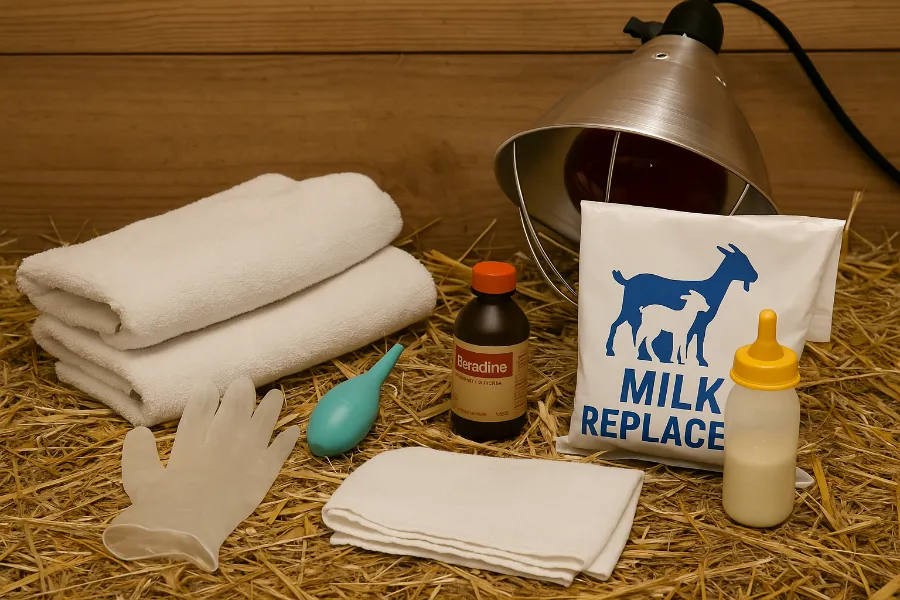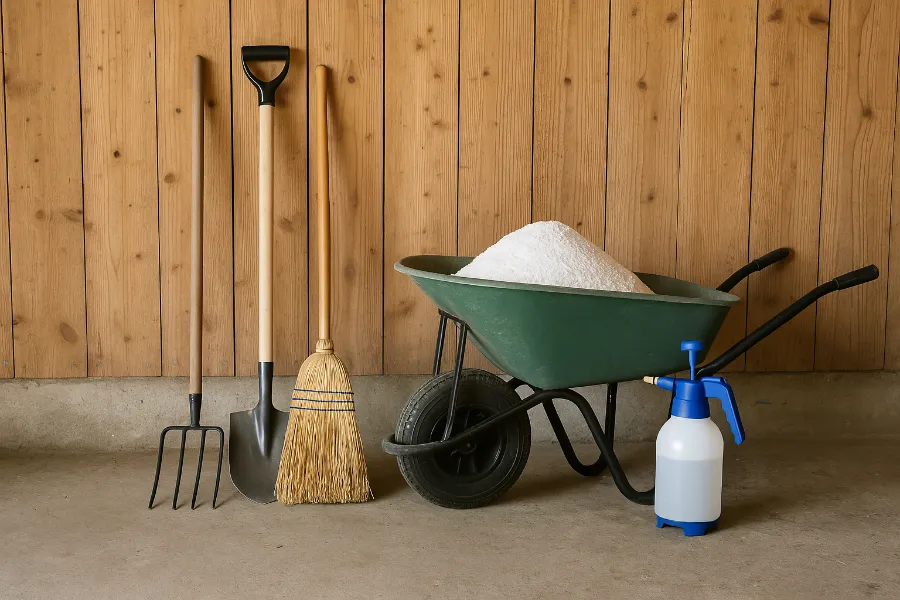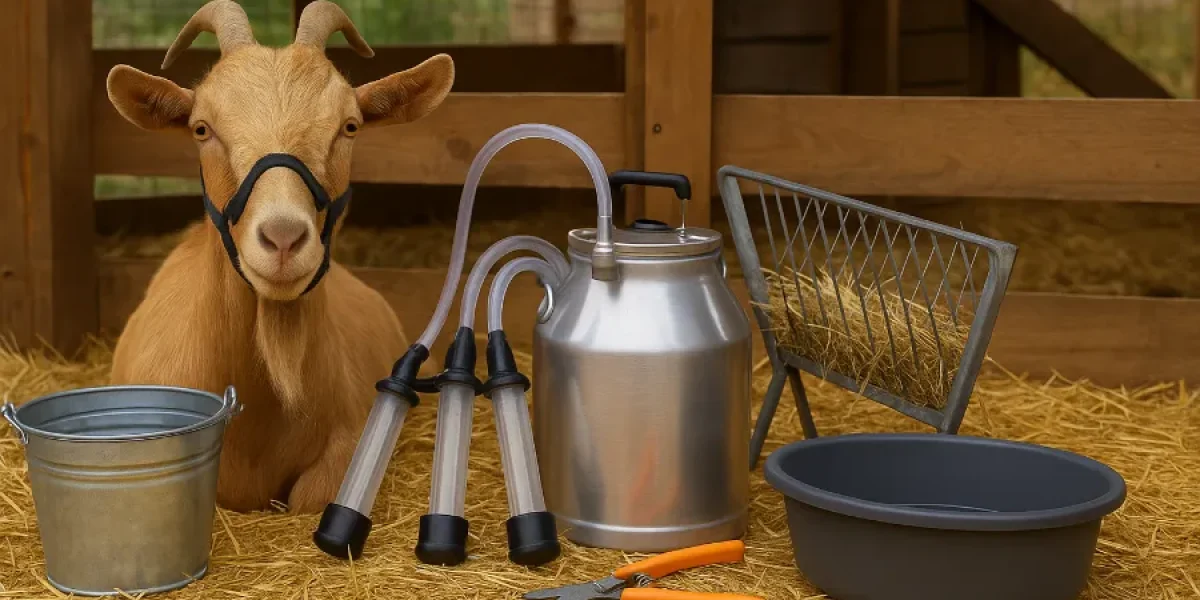When I first started my goat journey, I thought all I needed was a few goats, some hay, and a sturdy fence. I was wrong. Over time, I realized that essential tools for goat farming are what separate frustration from flow. The right goat farming equipment doesn’t just make life easier — it keeps your goats healthier, your work cleaner, and your routine sustainable.
In this post, I’ll share everything I’ve learned about goat farming tools, goat milking machines, goat fencing, goat supplies, goat milking supplies, hoof trimming tools, hay feeders, water troughs, goat halters, goat milking equipment, and automatic goat feeders — all from real experience. I’ll also walk you through the dos and don’ts, pros and cons, and what’s worth spending on versus what you can start simple with.
Why Goat Farming Equipment Matters
When you’re working with goats, every tool you use has a purpose. Some save you hours each week; others prevent injuries or improve milk quality. The right setup turns daily chores into an enjoyable rhythm instead of a stressful scramble.
My advice to any beginner: build your toolkit gradually. Start with what keeps your goats fed, fenced, milked, and healthy. Add convenience tools later once your herd and workflow stabilize.

Goat Farming Tools: The Everyday Essentials
Before worrying about advanced machines or fancy gadgets, get your hands on solid goat farming tools that handle daily needs.
Buckets, Feed Scoops, and Storage Bins
It sounds basic, but good buckets and scoops are the foundation of goat farming. I use sturdy metal and heavy-duty plastic buckets for water, feed, and mixing minerals. A reliable feed scoop keeps rations consistent and clean.
Do: Label buckets and bins so you never mix grain with supplements.
Don’t: Leave feed exposed — goats will find a way to knock it over.
A well-organized feeding corner saves endless frustration and wasted feed.
Goat Milking Equipment: From Hands-On to High-Tech
Milking time is sacred, and the right goat milking equipment can transform it from a chore into a peaceful routine. I started simple — just a bucket, towel, and stool — but once my herd grew, I learned how much the right setup matters.
Goat Milking Supplies for Beginners
Here’s what I used when I started milking by hand:
- Stainless steel milking pail (easy to sanitize)
- Strip cup (to check for mastitis)
- Soft towels and udder wash
- Teat dip cup and antiseptic solution
- Filter or strainer for clean milk transfer
Advantages:
- Affordable and simple
- Easy to clean and maintain
- Ideal for small herds
Disadvantages:
- Slower for large operations
- Physically demanding
- Higher chance of contamination if not careful
This setup works beautifully for one to three does and gives you a hands-on feel for each goat’s health.
Goat Milking Machine: When to Upgrade
After a few seasons of hand milking, I finally invested in a goat milking machine. It changed everything. My morning chores went from an hour of hand milking to twenty minutes of steady rhythm and clean milk.
Machines like Simple Pulse, Dansha Manual-Electric Hybrid, and VevoTech are great choices depending on herd size and power access.
Advantages:
- Faster and more hygienic
- Consistent suction for udder health
- Easier on your hands and back
Disadvantages:
- Higher upfront cost
- Must be cleaned thoroughly after each use
- Needs stable power or battery backup
Do: Sanitize tubing after every session.
Don’t: Use excessive suction — gentle is best for both milk flow and udder comfort.
Goat Fencing: Secure and Reliable
If there’s one thing goats love, it’s testing your patience — and your fences. Strong goat fencing is non-negotiable for safety, predator control, and pasture management.
Traditional vs. Modern Fencing Options
- Woven Wire Fencing (4×4 mesh): Long-lasting, safe for goats, and easy to repair.
- Electric Fencing: Perfect for rotational grazing; portable and effective.
- Premier 1 Electric Netting: A favorite for flexibility and ease of setup.
Do: Install strong corner posts to keep tension.
Don’t: Use barbed wire — it’s dangerous and easily tangled.
Advantages:
- Prevents escapes and predator intrusion
- Supports pasture rotation for parasite control
Disadvantages:
- Electric systems require maintenance
- Permanent fencing is costly upfront
For me, woven wire around the main pasture and electric netting for portable paddocks has been the best combination.

Goat Supplies for Feeding and Watering
Feeding and hydration systems are the heartbeat of any goat farm. These goat supplies keep your herd nourished, clean, and efficient.
Hay Feeder and Automatic Goat Feeder
Early on, I fed hay on the ground — big mistake. Goats trample, waste, and soil more hay than they eat. A proper hay feeder changed that immediately. Elevated, V-shaped, or wall-mounted designs minimize waste and contamination.
Later, I invested in an automatic goat feeder to regulate grain portions. It’s ideal for consistent feeding and saves hours of labor weekly.
Advantages:
- Cleaner feeding environment
- Prevents overfeeding
- Saves time during busy seasons
Disadvantages:
- Requires setup and occasional recalibration
- Needs monitoring to prevent grain waste
Do: Keep feeders elevated.
Don’t: Fill to the brim — it encourages waste and spoilage.
Water Troughs and Watering Systems
Hydration is essential to milk production and overall health. I use water troughs and automatic waterers depending on the pasture.
- Plastic or Galvanized Troughs: Durable and easy to clean.
- Automatic Waterers: Maintain constant water levels for large herds.
- Heated Buckets: Keep water from freezing in winter months.
Advantages:
- Ensures constant hydration
- Reduces labor time
- Supports consistent milk output
Disadvantages:
- Requires frequent cleaning in warm weather
- Heated options use more energy
Do: Scrub weekly to prevent algae.
Don’t: Let troughs fill with debris or leaves.
Hoof Trimming Tools: For Health and Mobility
Healthy hooves mean happy goats. Neglect them, and you’ll deal with pain, infections, and limping animals. I learned that lesson quickly.
Hoof Trimming Tools You’ll Need
- Hoof trimmers or shears
- Hoof pick for debris
- Rasp or file for smoothing edges
Do: Trim every 4–6 weeks.
Don’t: Cut too close to the quick — bleeding causes pain and infection.
Advantages:
- Prevents hoof rot
- Improves walking and grazing balance
Disadvantages:
- Requires steady hands and practice
- Dull tools can injure goats
Invest in high-quality shears like Zenport or ARS — they’ll last for years if you clean and oil them.

Goat Halter and Handling Equipment
A sturdy goat halter is one of my favorite low-cost tools. It helps you lead, restrain, and train goats safely without stress or chaos.
How I Use My Goat Halters
I keep halters for each adult goat, fitted snugly to avoid slipping. They make hoof trimming, vet care, and training sessions easier and safer.
Advantages:
- Easier control during handling
- Safer for both goat and farmer
Disadvantages:
- Poor fit causes rubbing
- Loose halters can slip off easily
Do: Choose adjustable nylon halters with sturdy buckles.
Don’t: Substitute with dog collars — they don’t offer proper control.
Goat Health and First Aid Supplies
Preparedness matters more than fancy tech. Having the right goat supplies for health and emergencies gives peace of mind when something goes wrong.
First Aid and Health Essentials
- Digital thermometer
- Antiseptic, iodine, and wound sprays
- Drench gun for deworming
- FAMACHA card for parasite checks
- Gloves, syringes, and cotton pads
Do: Keep everything in a labeled container.
Don’t: Wait until emergencies to find supplies — stock them early.
A well-maintained health kit has saved me from multiple vet emergencies.
Breeding, Kidding, and Record Tools
When kidding season arrives, being prepared makes all the difference.
Kidding Essentials
- Clean towels and gloves
- Bulb syringe for clearing airways
- Iodine for navels
- Heat lamp for cold kids
- Milk replacer and bottle supplies
Keep a small scale handy for weighing newborns. Recording births, breeding cycles, and health notes in a simple notebook or app helps track herd progress.
Cleaning and Maintenance Equipment
A clean barn is the foundation of herd health. I learned that regular maintenance prevents disease and odor problems.
Essential Cleaning Tools
- Pitchfork, shovel, broom, and wheelbarrow
- Lime powder or absorbent bedding
- Disinfectant sprayer for stalls and milk area
Do: Muck out weekly, or daily in wet weather.
Don’t: Mix bleach and ammonia — it produces toxic fumes.
Clean tools and barns equal healthy goats and fresher air for you.
Comparing Quality: Best to Budget
| Tool Type | Best Quality | Mid-Range | Budget-Friendly |
|---|---|---|---|
| Hoof Trimmers | Zenport Q140DX | ARS 120DX | Generic brand |
| Milking Machine | Simple Pulse | Dansha Hybrid | Manual hand pump |
| Fencing | Premier 1 Electric | Zareba Polywire | Nylon rope fence |
| Hay Feeder | Behlen Country V-Rack | Little Giant | DIY wooden trough |
| Water Trough | Rubbermaid Stock Tank | Tractor Supply Tank | Basic plastic bin |
| Automatic Feeder | VevoTech Smart Feeder | Caprine Feeder | Gravity-feed tub |
Always invest most in fencing, health tools, and milking equipment — they have the biggest impact on your herd’s safety and productivity.
Dos and Don’ts of Goat Farming Equipment
Do:
- Choose durable, easy-to-clean materials
- Sanitize milking and feeding equipment daily
- Inspect fences weekly
- Store tools under shelter
- Keep records for maintenance and replacements
Don’t:
- Use barbed wire
- Leave tools dirty or damp
- Ignore routine maintenance
- Mix chemical cleaners around feed
- Skip hoof care
Advantages of Quality Goat Farming Equipment
- Boosts efficiency in daily chores
- Improves milk yield and cleanliness
- Reduces disease risk
- Keeps goats safer and calmer
- Saves time and money long-term
Disadvantages and Trade-Offs
Even the best tools come with challenges:
- Expensive upfront cost
- Power dependence for automatic systems
- Regular maintenance required
- Cleaning can be time-consuming
But over time, the investment in reliable tools pays back in better herd health and less daily stress.
Traditional to Modern: Growing with Your Herd
Here’s how my setup evolved:
- Traditional: Hand milking, woven wire fencing, manual hoof trimmers.
- Intermediate: Electric net fencing, heated water buckets, basic feeders.
- Modern: Goat milking machine, automatic goat feeder, digital herd tracking.
Each stage built on the last — I didn’t need everything at once. I focused on essentials first, then slowly modernized.
Final Thoughts: Equip Smart, Farm Better
The heart of goat farming isn’t just your animals — it’s your routine. And that rhythm is powered by your tools. The right goat farming equipment turns long days into fulfilling ones, reduces stress, and lets your goats thrive.
Start small, buy quality, and upgrade over time. A well-built fence, sharp hoof trimmers, and a clean milking setup will take you farther than any fancy gadget.
Goat farming is as much about skill and heart as it is about tools. Build your toolkit wisely, maintain it faithfully, and your herd — and your sanity — will thank you every season.
FAQs
Beginners should start with buckets, fencing, hoof trimmers, milking supplies, and feeding tools. These basics keep goats healthy and chores manageable.
High-quality tools last longer, reduce injuries, and improve goat health. They also make milking, feeding, and cleaning faster and more hygienic.
Milking supplies are for hand milking, while milking machines automate the process. Machines save time but require more maintenance and investment.
Use proper hoof trimming tools every 4–6 weeks, depending on terrain and growth. Regular trimming prevents lameness and hoof infections.
Woven wire and electric fencing are the most reliable. They prevent escapes, deter predators, and support pasture rotation.
Yes, for larger herds or busy farms. They reduce feeding time, regulate portions, and help maintain consistent feeding schedules.
Wash all metal and plastic tools after use, especially milking and feeding gear. Dry and store them indoors to prevent rust or contamination.













